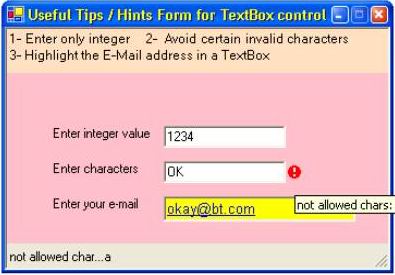Introduction
This project will show a different way how to:
- enter only integer value in a
TextBox.
- enter only the characters you want and avoid certain invalid characters in a
TextBox.
- highlight the E-Mail address in a
TextBox in color.
- and check whether the E-Mail address is a valid or an invalid one.
through the class System.Text.RegularExpressions.Regex(). It will also show how you can use ErrorProvider and ToolTip when you enter false values in a TextBox.

Code and How it works
I use 3 TextBoxes. textboxInteger is for integer values, textboxEmail for E-Mail addresses, and textboxChars for char values. Let's start with TextBox 'textboxInteger'.
As mentioned before, you can enter here only integer values. Other characters will not be accepted.
Here is the method for input integer:
private void textboxInteger_KeyPress(object sender,
System.Windows.Forms.KeyPressEventArgs e)
{
if (!Char.IsDigit(e.KeyChar) && e.KeyChar !=(char)8)
{
this.statusBar1.Text="incorrect key...";
e.Handled=true;
} else
this.statusBar1.Text="OK..";
}
As you can see, we check whether the char you typed in the TextBox is a decimal digit or backspace-key for deleting the chars. If it's not, we won't pass it on to the control so that you can't see it in the TextBox(e.Handled=true). Otherwise, we display the status bar text saying "OK.." which means you entered correct decimal digits.
TextBox 'textboxChars'
We want here to avoid entering certain invalid characters (i.e., 'a','b','c','#','*','1'). To solve this, I implemented 3 methods in Form1.cs:
mTextboxCharsKeyPressWithForeach
mTextboxCharsKeyPressWithIF
mTextboxCharsKeyPressWithSwitch
that I prefer:
private void mTextboxCharsKeyPressWithSwitch(object sender,
System.Windows.Forms.KeyPressEventArgs e)
{
this.statusBar1.Text="OK...";
switch(e.KeyChar)
{
case 'a':
case 'b':
case 'c':
case '#':
case '*':
case '1':
e.Handled=true;
this.errorProvider1.SetError(this.textboxChars,
"not allowed chars: 'a','b','c','#','*','1'");
this.statusBar1.Text="not allowed char..."+e.KeyChar;
break;
default:
this.errorProvider1.SetError(this.textboxChars, "");
break;
}
}
If the chars you typed are 'a', 'b', 'c', '#', '*', '1', then we use an ErrorProvider and ToolTip control on the TextBox. An error icon appears next to the TextBox. If you hold the mouse pointer over the error icon, a tool tip appears displaying the error message.
TextBox 'textboxEmail'
As soon as you typed a correct e-mail address, it will change the BackColor of TextBox to yellow and ForeColor to blue underlined. And it will also show in a MessageBox the user name and host name. If you miss entering after @, it will show it's not a valid e-mail address. The method for the TextBox 'textboxEmail':
private void textboxEmail_TextChanged(object sender, System.EventArgs e)
{
if (this.textboxEmail.Text.IndexOf("@") != -1
&& this.textboxEmail.Text.IndexOf(".") != -1)
{
this.textboxEmail.BackColor=Color.Yellow;
this.textboxEmail.ForeColor=Color.Blue;
this.textboxEmail.Font=new Font("Arial",
10, FontStyle.Underline);
}
else
{
this.textboxEmail.BackColor=Color.White;
this.textboxEmail.ForeColor=Color.Black;
this.textboxEmail.Font=new Font("Arial",
10, FontStyle.Regular);
}
}
The indexOf method returns an integer value indicating the beginning of the substring within the String object. If the substring is not found, a -1 is returned. If a valid e-mail address was entered, BackColor and ForeColor will be changed and the FontStyle will be "FontStyle.Underline". Otherwise, it will change to old style.
To check whether it's a valid or invalid e-mail address, I use with the help of regular expression, a pattern match to validate the e-mail address. Here is the method.
private void textboxEmail_Validating(object sender,
System.ComponentModel.CancelEventArgs e)
{
Regex emailregex = new Regex("(?[^@]+)@(?.+)");
Match mmatch = emailregex.Match(this.textboxEmail.Text);
if ( mmatch.Success )
{
MessageBox.Show("UserName: " +
mmatch.Groups["user"].Value+"\n"+"HostName: " +
mmatch.Groups["host"].Value,"E-Mail Information");
this.statusBar1.Text="";
}
else
{
MessageBox.Show("invalid e-mail address...","E-Mail Information");
e.Cancel=true;
}
}
The Match object returns regardless of whether any matches were found in the source string. With the Success property, we can decide whether to continue processing the Match object or to display an error message. If successful, we display the "user" and "host" named groups within the Groups collection of the Match object. Otherwise, you try it again. Make sure that the first half of the string does not have an @ symbol.
In conclusion
I've designed this program to show the basics to the beginners. Who knows maybe the experts could make good use of some hints/tips here.
Enjoy and good coding!
H�seyin Altindag
